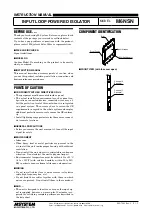
Chapter 4. CPU Operation
GFK-2222AD
April 2018
169
Default Conditions for I/O Modules
Interrupts
Some input modules can be configured to send an interrupt to the application program. By default, this
interrupt is disabled and the input filter is set to slow. If changed by the programming software, the new
settings are applied when the configuration is stored and during subsequent power-cycles.
Outputs
Some output modules have a configurable output default mode that can be specified as either Off or
Hold Last State. If a module does not have a configurable output default mode, its output default mode
is Off. The selected action applies when the CPU transitions from RUN/Enabled to RUN/Disabled or STOP
Mode, or experiences a fatal fault.
At power-up, Series 90-30 discrete output modules default to all outputs off. They will retain this default
condition until the first output scan from the PACSystems controller. Analog output modules can be
configured with a jumper located on the removable terminal block of the module. The jumper may be set
to cause outputs to either
default to zero
or
retain last state
.
Inputs
Input modules that have a configurable input default mode can be configured to Hold Last State or to set
inputs to 0. If a module does not have a configurable input default mode, its input default mode is Off.
The selected action applies when the CPU transitions from RUN/Enabled to RUN/Disabled or STOP Mode,
or experiences a fatal fault.
For details on the power-up and STOP Mode behavior of other modules, refer to the documentation for
that module.
Multiple I/O Scan Sets
Up to 32 I/O scan sets can be defined for a PACSystems CPU. A scan set is a group of I/O modules that
can be assigned a unique scan rate. A given I/O module can belong to one scan set. By default, all I/O
modules are assigned to scan set 1, which is scanned every sweep.
For some applications, the CPU logic does not need to have the I/O information every sweep. The I/O
scan set feature allows the scanning of I/O points to be more closely scheduled with their use in user
logic programs. If you have a large number of I/O modules, you may be able to significantly reduce scan
time by staggering the scanning of those modules.
A disadvantage of placing all modules into different scan sets appears when the CPU is transitioning from
Stop to Run. In that case, scan sets with a programmed delay are not scanned on the first sweep. These
modules' outputs are not enabled until the new data has been scanned to them, perhaps many scans
later. Therefore, there is a period of time during which the user logic is executing and some modules'
outputs are disabled. During that time, outputs of those modules are in the module’s stop
-mode state.
Stop-mode behavior is module-dependent. Some modules zero their outputs, some hold their last
scanned state (if any), and some force their outputs to a configured default value. When the module's
outputs are enabled, the module uses the last scanned value, which will either be zero or the contents
of the register the module uses to hold the corresponding output values from the reference tables.
















































